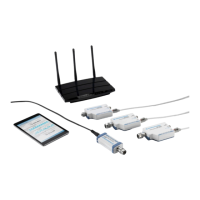Preparing for use
R&S
®
NRPxxS(N)
16User Manual 1177.5079.02 ─ 15
See Table 4-1.
2. Inspect both RF connectors carefully. Look for metal particles, contaminants and
defects.
If either RF connector is damaged, do not proceed, because the risk of damaging
the mating connector is too high.
See also Chapter 14.1, "Regular checks", on page 174.
3. Insert the RF connector straight into the RF output of your DUT. Take care not to tilt
it.
180
NRP
3-Path Diode Power Sensor
MHz to GHz, 100 pW to 200 mW (−70 dBm to +23 dBm)
SMART SENSOR TECHNOLOGY
4.
NOTICE! Risk of damaging the center pin of the RF connector. Only rotate the hex
nut of the RF connector. Never rotate the power sensor itself.
Tighten the RF connector manually.
5. Tighten the RF connector using a torque wrench with the nominal torque recom-
mended in Chapter 4.1, "RF connector", on page 27 to ensure maximum mea-
surement accuracy.
To disconnect from the DUT
1.
NOTICE! Risk of damaging the center pin of the RF connector. Only rotate the hex
nut of the RF connector. Never rotate the power sensor itself.
Carefully loosen the union nut at the front of the RF connector of the power sensor.
2. Remove the power sensor.
3.5 Powering the power sensor
The electrical power for the R&S NRPxxS(N) is supplied over one of the following inter-
faces:
●
Host interface
See Chapter 4.3, "Host interface", on page 29.
●
LAN PoE interface
Available only for LAN power sensors. See Chapter 4.5, "LAN PoE interface",
on page 29.
If you use the Ethernet interface of the LAN power sensors, you have to provide the
electrical power by power over Ethernet (PoE). In this case, you cannot provide the
electrical power over the host interface instead.
Powering the power sensor

